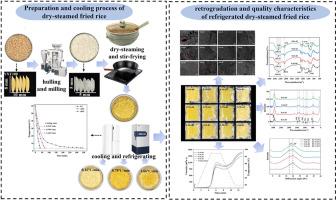Effect of cooling rate on the retrogradation properties and quality of refrigerated dry-steamed fried rice
IF 3.9
2区 农林科学
Q2 FOOD SCIENCE & TECHNOLOGY
引用次数: 0
Abstract
The cooling rate is an important factor affecting the quality of refrigerated fried rice. The effect of the cooling rate (0.16 °C/min, 0.78 °C/min, 1.66 °C/min) on the retrogradation properties of dry-steamed fried rice during the refrigeration period (0–3 d) was investigated. The increased cooling rate from 0.16 to 1.66 °C/min led to a weakening of stability of the fried rice gel and an increase in the loss of moisture content of the fried rice from 0.86% to 7.11% after 3 d of refrigeration. The cooling rate of 0.78 °C/min slowed the increase in hardness of fried rice and resulted in a lower short-range ordering (0.85) as well as the least increase in relative crystallinity (9.51%) after 3 d of refrigeration. However, a cooling rate of 1.66 °C/min resulted in a crispy texture and the worst sensory quality of the fried rice after reheating. Both the 0.16 °C/min and the 1.66 °C/min cooling rates increased the viscosity and reduced the thermal stability of the fried rice paste system. In contrast, a cooling rate of 0.78 °C/min is the most suitable cooling rate for refrigerated dry-steamed fried rice. These results will be of guiding significance for regulating the regrowth of dry-steamed fried rice by changing the cooling rate.

冷却速度对冷藏干蒸炒饭逆变特性和质量的影响
冷却速度是影响冷藏炒米质量的一个重要因素。研究了冷却速度(0.16 °C/min、0.78 °C/min、1.66 °C/min)对干蒸炒饭在冷藏期(0-3 d)的逆变特性的影响。在冷藏 3 d 后,冷却速率从 0.16 ℃/min 增加到 1.66 ℃/min,导致炒米凝胶的稳定性减弱,炒米的水分损失从 0.86% 增加到 7.11%。0.78 °C/min 的冷却速率减缓了炒米硬度的增加,并导致较低的短程有序度(0.85),以及冷藏 3 d 后相对结晶度的最小增加(9.51%)。然而,1.66 °C/分钟的冷却速度导致炒饭质地酥脆,重新加热后的感官质量最差。0.16 °C/分钟和 1.66 °C/分钟的冷却速度都会增加炒米糊体系的粘度并降低其热稳定性。相比之下,0.78 °C/分钟的冷却速率最适合冷藏干蒸炒饭。这些结果对于通过改变冷却速率来调节干蒸炒饭的再生具有指导意义。
本文章由计算机程序翻译,如有差异,请以英文原文为准。
求助全文
约1分钟内获得全文
求助全文
来源期刊

Journal of Cereal Science
工程技术-食品科技
CiteScore
7.80
自引率
2.60%
发文量
163
审稿时长
38 days
期刊介绍:
The Journal of Cereal Science was established in 1983 to provide an International forum for the publication of original research papers of high standing covering all aspects of cereal science related to the functional and nutritional quality of cereal grains (true cereals - members of the Poaceae family and starchy pseudocereals - members of the Amaranthaceae, Chenopodiaceae and Polygonaceae families) and their products, in relation to the cereals used. The journal also publishes concise and critical review articles appraising the status and future directions of specific areas of cereal science and short communications that present news of important advances in research. The journal aims at topicality and at providing comprehensive coverage of progress in the field.
 求助内容:
求助内容: 应助结果提醒方式:
应助结果提醒方式:


